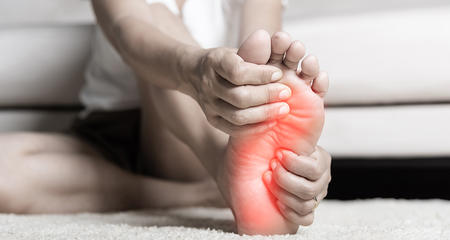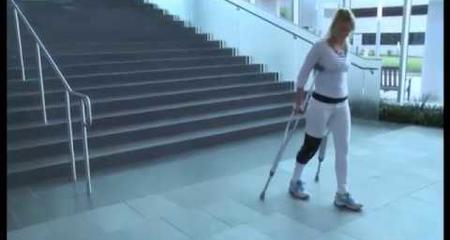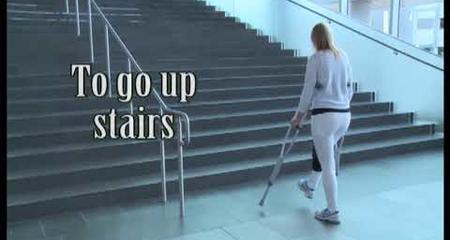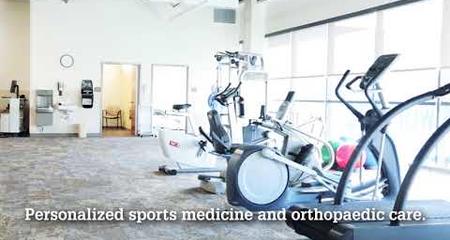As a leading foot and ankle program in Wisconsin and the upper Midwest, our staff provide comprehensive care for the full range of foot and ankle disorders, including:
- Arthritis
- Bunion (hallux valgus)
- Congenital deformities
- Diabetes-related concerns and other medically related conditions such as wound care
- Flat feet
- Haglund's deformity or “pump bump”
- Hallux rigidus (stiff big toe)
- Hammer toes, claw toes and mallet toes
- Nerve entrapment (pinched nerve), including Morton’s neuroma and tarsal tunnel
- Plantar fasciitis
- Sports injuries, including ankle sprains
- Trauma
Arthritis of the Foot and Ankle
Several types of arthritis can affect the ankle and foot joints — osteoarthritis, rheumatoid arthritis and arthritis caused by fracture, dislocation, inflammatory disease or congenital deformity.
- Osteoarthritis occurs when the cartilage of the joints becomes worn or frayed from “wear and tear” as patients age.
- Arthritis due to injury and other causes is similar to osteoarthritis. Symptoms include pain, stiffness, swelling and diminished or loss of motion through the joints.
- Rheumatoid arthritis creates inflammation of the synovium, a thin layer of tissue that lines the joint space. There may be weakening of the supporting structures of the joints, and bunions, claw toes, hammer toes or rheumatoid nodules may develop. Patients may feel like they are walking on marbles.
Common arthritis treatments are medications, bracing and shoe modification or surgery. Surgical options for ankle arthritis may be ankle fusion or total ankle replacement.
Bunion
A bunion (hallux valgus) is the lateral deviation of the great toe (hallux). Bunions can be caused by footwear, heredity, flat feet, soft tissue laxity due to rheumatoid arthritis, gout or trauma. Learn more about bunion surgery and other treatments.
Flat Feet
Flat feet, also called pes planovalgus or pes planus, occurs more often as people age. Formally called “adult acquired flatfoot,” it is commonly caused by posterior tibial tendon dysfunction, or PTTD. This tendon is primarily responsible for maintaining the arch and proper alignment of the foot and ankle. The tendon may lose its supportive function as a result of degenerative changes or injury, causing the arch to collapse and the foot to turn outward. Treatments for flat feet include immobilization, physical therapy, medications, orthotics, bracing and surgery.
Haglund's Deformity or “Pump Bump”
Haglund's deformity or "pump bump" is a bony enlargement at the back of the heel. Pain is aggravated by shoe wear, especially pumps (shoes with higher heels) worn by women, and certain activities.
Patients may wear open back shoes to avoid pressure to the posterior heel. Treatments for Haglund’s deformity (“pump bump”) include shoe modification, immobilization, medications and surgery.
Hallux Rigidus (Stiff Big Toe)
The metatarsophalangeal (MTP) joint of the big toe (hallux) is important because it has to bend with each step. If it stiffens due to arthritis, injury or other factors, walking can become painful. Treatments for a stiff big toe or hallux rigidus may include orthotics and surgery.
Hammer Toes, Claw Toes and Mallet Toes
Deformities of the “lesser toes” occur when the joints are contracted, becoming stiff or immobilized. They are classified as hammer toes, claw toes, or mallet toes and are caused by improper footwear, arthritis, loss of intrinsic muscle function or trauma.
Surgery may be required to remove the contracted joint or correct contracted tendons. Learn more about treatments of hammer toes, claw toes, or mallet toes.
Nerve Entrapment (Pinched Nerve)
A pinched nerve, or nerve entrapment, can occur in various locations in the foot and ankle. The condition develops when nerves are compressed due to trauma, pressure from swelling, weight gain, improper footwear and other conditions. Common forms of nerve entrapment include:
- Morton's Neuroma
A neuroma is a benign growth or inflammation of nerve tissue. Morton's neuroma occurs in a nerve in the foot that runs between the third and fourth toes. Symptoms include a burning or shooting pain that radiates into the toes. Rest and removal of shoes can alleviate the symptoms, but other treatments for Morton’s neuroma may be required, including orthotics, shoe modification, medication and surgery.
- Tarsal Tunnel Syndrome
Similar to carpal tunnel syndrome of the wrist, tarsal tunnel syndrome is an entrapment of the nerve that descends under the inside ankle area and into the foot. Symptoms include burning, tingling sensations, shooting pain, numbness and cramping in the feet. Treatment of tarsal tunnel syndrome ranges from cortisone injections and anti-inflammatory medications to orthotics and surgery.
Virtual Visits Are Available
Safe and convenient virtual visits by video let you get the care you need via a mobile device, tablet or computer wherever you are. We'll assess your condition and develop a treatment plan right away. To schedule a virtual visit, call 414-777-7700.
More to Explore





